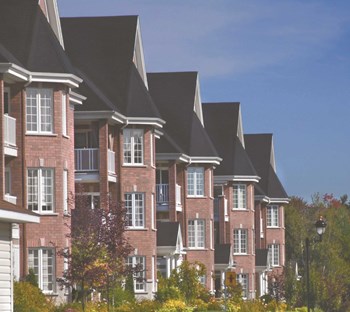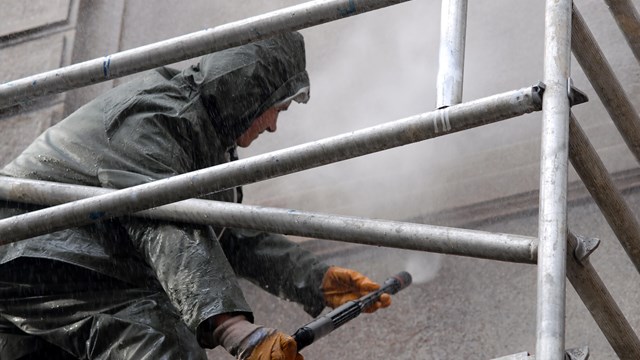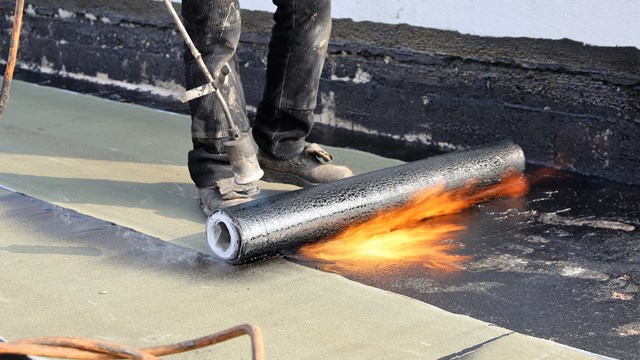
Let's take an imaginary walk with a prospective buyer up to the doorway of their future home in your condominium development. Take a look at the wilted, dried-up flowerbeds that haven't seen care or maintenance in months. Attractive, aren't they? Or what about the common area that's dotted with rusted, broken patio furniture that the association board has been talking about replacing for years? Or the neighbor's array of blinking neon holiday signs? Maybe they'll put them away before next Christmas, even though you have sent them too many notices to count. And let's not even get started on the front doors that are crying out for a new paint job. If you were thinking of purchasing a home, would you sign on the dotted line in a community in such disarray?
Probably not. A large percentage of homebuyers decide whether or not to look inside a house based on its "curb appeal"—which is the view they see when they drive by or arrive for a showing. Attractiveness and curb appeal are both vital to an association's sense of community pride and overall value. After all, it's hard to attract prospective homebuyers if the flowerbeds are unruly, or members' homes or units are shabby, mismatched, and in disarray.
So what is curb appeal? It involves a wide range of factors, from making certain improvements to the property, such as planting a beautiful landscape, to painting the doors, cleaning the windows or adding special accessories, like better lighting, attractive mailboxes or even doormats.
Check the Rules
As important as they are, it will come as no surprise to boards and managers that aesthetics and matters of taste can be some of the most hotly debated aspects of HOA administration. Thankfully, when deciding on the exterior aesthetics of an association, there are usually at least a few guidelines or rules in place that determine what's allowed and what's prohibited.
"The developer has already developed the bylaws and it's already set up to benefit the neighborhood," says Dean N. Carpenter, chief executive officer of Houston Landscapes Unlimited, a national landscaping company based in Sugarland, Texas. "The developer's whole objective is to do a first-class job and design beautiful curb appeal to increase the building's visibility and invite people to come into the home and to try and sway them to buy in the neighborhood."
However, while bylaws are meant to be followed, there will always be association members who flout the rules and insist on doing things their way—sometimes to less-than-tasteful effect. Putting the kibosh on that is vital to the success of any HOA's curb appeal efforts.
"The most important aspect of curb appeal is to strongly enforce the rules that have been set down," says Bruce Hellerick, a senior horticulture specialist with The Brickman Group in Langhorne, Pennsylvania. "If one resident does one little thing, the next person goes completely crazy, until basically it's a free-for-all. Communities which are strict have a consistent level of quality and an image the community is trying to protect."
Those interviewed for this article agree that there really isn't one controversial design or aesthetic choice that regularly sparks debate among residents, but residents can show persistence when wanting to make their own personal touches outside of their home.
"Many residents have difficulty with the idea they have to abide by their association's rules," says Hellerick. "We report to the board or management company and not the individual homeowner, so for example, if they agreed when they moved in that there is no planting [in certain areas,] then go ahead and plant something, we'll pull it out."
Rockin' the Benefits
Once the unruliness grows, Hellerick says that it may be more difficult to tame it. Since an attractive exterior comes with an array of benefits for the association and the individual homeowner, uncooperative residents may actually affect the property's bottom line.
"Everyone would like to be part of something that's greater," says Marianne Cusato, New York-based designer and author of Get Your House Right; The Value of Design."Presumably when you come into an association, you are getting more for your money than if you bought an individual home. Property values are linked to the association, so you want more for your money."
When deciding on what your property needs to successfully create curb appeal, Cusato suggests looking at other successful neighborhoods in the area.
"Look for precedents," she says. "The best thing to do is look around and see what works and what doesn't work, and then model after that. You can also hire a professional to come in and help you decide the right elements that you need, such as successful street signs, and things like that."
But like most things in this world, the reality is that you have to spend money to make money—or generate value—and everything costs money. Even a simple paint job for a large lobby and hallways or the entire exterior can cost thousands. Add in lighting fixtures, new plantings and a new sign pointing to the great association, and you might be looking at a budget-buster or a major hike in monthly fees, especially if you're not prepared.
Think Long-Term
However, Cusato also says that an investment today leads to a larger payoff tomorrow.
"Think not just for the short-term, but instead think about what it's going to look like five, 10 or 15 years from now," she says. "If you're going to maintain the value for everybody, you need to use good materials. The better materials you use, the fewer times you have to redo things."
At the same time, Cusato says that a low-maintenance property is actually better than a no-maintenance property. "In a no-maintenance home, when things fail, they usually have to be completely replaced, but if you participate in the maintenance of the building, those materials will last much longer."
Also, buck the trends and stick with what lasts. If an association wants to be hip, stylish, and trendy, that's okay, but be prepared for the consequences: you'll be changing the look every few years when the fad fades, resulting in spending more money to upgrade the property again.
Beyond Flowers—Think Green
Often when people think about curb appeal, it's all about the landscaping, but it's important to stretch your imagination beyond that. Don't just invest in flowers and shrubbery. Think about the whole picture. Remember the run-down outdoor furniture in our opening example? It's a real eyesore when potential homeowners are walking around and inspecting the property.
"One of the first things a potential [resident] will see is the outside common area, so it shouldn't be run down," says Patrick M. Foley, president of the Southern Company Inc. in Willow Grove, Pennsylvania. "If the property manager is looking at cost factors for curb appeal, you can buy outdoor furniture at stores like Kmart, Sears, or Target, but it is not as well-made as other stuff, which you can refinish or repair, and make last longer."
Foley urges property managers to forego bringing current outdoor furniture to the landfill and instead, do the 'green thing' and repair what they already have, if possible. His company refurbishes older outdoor furniture—including wrought-iron pieces—with new paint, straps, slings and finishes, making it new again and making HOA common areas more attractive.
So let's take another imaginary walk up to the doorway of your future association member's new home, shall we? Take a look at the beautiful bed of tulips, the perfectly pruned rose bush and smell the fragrant aroma of the peony plant. Over to the right is the new common area where the residents will enjoy spending time playing with their children for hours and relaxing on comfortable patio furniture. To their left is, well just more of the same because the neighbors cannot display year-round neon blinking holiday signs, thanks to property managers who adhere to the association bylaws.
By sticking to the rules in a fair and consistent way, and committing to regular, thorough upkeep of grounds, landscaping, common areas, and amenities, your association can watch curb appeal translate into not just increased values, but happier residents.
Lisa Iannucci is a freelance writer and author living in Poughkeepsie, New York.






Leave a Comment